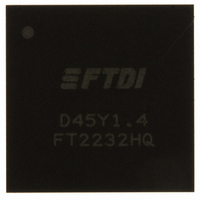FT2232HQ - REEL FTDI, Future Technology Devices International Ltd, FT2232HQ - REEL Datasheet - Page 12

FT2232HQ - REEL
Manufacturer Part Number
FT2232HQ - REEL
Description
IC USB UART/FIFO DUAL HS 64-QFN
Manufacturer
FTDI, Future Technology Devices International Ltd
Series
USBmadeEZ-FIFOr
Datasheet
1.FT2232HQ_-_REEL.pdf
(63 pages)
Specifications of FT2232HQ - REEL
Features
USB to UART and/or FIFO, SPI, I2C, JTAG
Number Of Channels
2, DUART
Fifo's
4096 Byte
Protocol
RS-232, RS-422, RS-485
Voltage - Supply
3 V ~ 3.6 V
With Parallel Port
Yes
With Auto Flow Control
Yes
With Modem Control
Yes
With Cmos
Yes
Mounting Type
Surface Mount
Package / Case
64-QFN
Lead Free Status / RoHS Status
Lead free / RoHS Compliant
Other names
768-1025-2
FT2232HQ - REEL
FT2232HQ - REEL
3.4.2 FT2232H pins used in an FT245 Style Synchronous FIFO Interface
The FT2232H only channel A can be configured as a FT245 style synchronous FIFO interface. When
configured in this mode, the pins used and the descriptions of the signals are shown in Table 3.5. To
enter this mode the external EEPROM must be set to make port A 245 mode. A software command (Set
Bit Mode option) is then sent by the application to the FTDI driver to tell the chip to enter single channel
synchronous FIFO mode. In this mode the „B‟ channel is not available as all resources have been switched
onto channel A. In this mode, data is written or read on the rising edge of the CLKOUT.
Table 3.5 Channel A FT245 Style Synchronous FIFO Configured Pin Descriptions
For a functional description of this mode, please refer to section 4.4
24,23,22,21,
19,18,17,16
Channel A
Pin No.
26
27
28
29
32
33
30
ADBUS[7:0]
CLKOUT
Name
RXF#
SIWU
TXE#
WR#
Copyright © 2010 Future Technology Devices International Limited
RD#
OE#
FT2232H DUAL HIGH SPEED USB TO MULTIPURPOSE UART/FIFO IC
OUTPUT
OUTPUT
OUTPUT
INPUT
INPUT
INPUT
INPUT
Type
I/O
D7 to D0 bidirectional FIFO data. This bus is normally input unless
OE# is low.
When high, do not read data from the FIFO. When low, there is data
available in the FIFO which can be read by driving RD# low. When in
synchronous mode, data is transferred on every clock that RXF# and
RD# are both low. Note that the OE# pin must be driven low at least
1 clock period before asserting RD# low.
When high, do not write data into the FIFO. When low, data can be
written into the FIFO by driving WR# low. When in synchronous
mode, data is transferred on every clock that TXE# and WR# are both
low.
Enables the current FIFO data byte to be driven onto D0...D7 when
RD# goes low. The next FIFO data byte (if available) is fetched from
the receive FIFO buffer each CLKOUT cycle until RD# goes high.
Enables the data byte on the D0...D7 pins to be written into the
transmit FIFO buffer when WR# is low. The next FIFO data byte is
written to the transmit FIFO buffer each CLKOUT cycle until WR# goes
high.
60 MHz Clock driven from the chip. All signals should be synchronized
to this clock.
Output enable when low to drive data onto D0-7. This should be
driven low at least 1 clock period before driving RD# low to allow for
data buffer turn-around.
The Send Immediate / WakeUp signal combines two functions on a
single pin. If USB is in suspend mode (PWREN# = 1) and remote
wakeup is enabled in the EEPROM , strobing this pin low will cause the
device to request a resume on the USB Bus. Normally, this can be
used to wake up the Host PC.
During normal operation (PWREN# = 0), if this pin is strobed low any
data in the device TX buffer will be sent out over USB on the next
Bulk-IN request from the drivers regardless of the pending packet
size. This can be used to optimize USB transfer speed for some
applications. Tie this pin to VCCIO if not used. (Also see note 1, 2, 3
in section 4.12)
FT245 Configuration Description
Document No.: FT_000061
Clearance No.: FTDI#77
Datasheet Version 2.10
12















